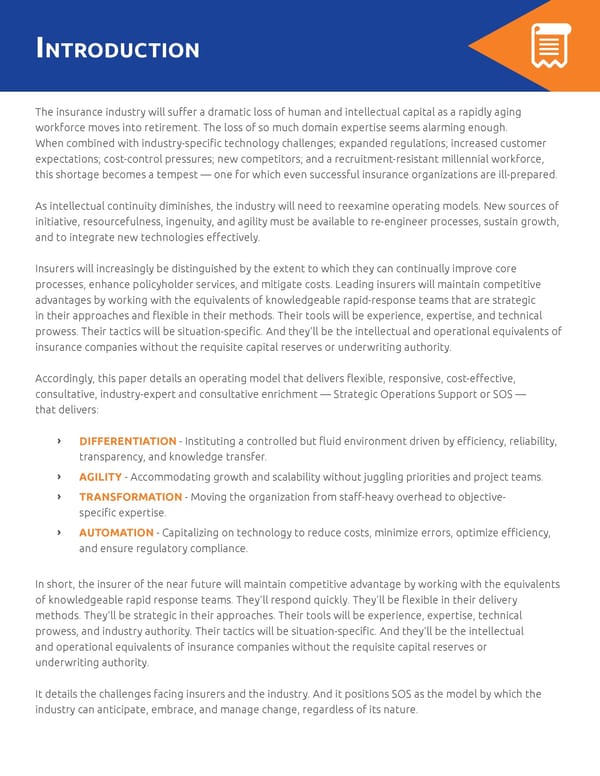IntroductIon The insurance industry will suffer a dramatic loss of human and intellectual capital as a rapidly aging workforce moves into retirement. The loss of so much domain expertise seems alarming enough. When combined with industry-specific technology challenges; expanded regulations; increased customer expectations; cost-control pressures; new competitors; and a recruitment-resistant millennial workforce, this shortage becomes a tempest — one for which even successful insurance organizations are ill-prepared. As intellectual continuity diminishes, the industry will need to reexamine operating models. New sources of initiative, resourcefulness, ingenuity, and agility must be available to re-engineer processes, sustain growth, and to integrate new technologies effectively. Insurers will increasingly be distinguished by the extent to which they can continually improve core processes, enhance policyholder services, and mitigate costs. Leading insurers will maintain competitive advantages by working with the equivalents of knowledgeable rapid-response teams that are strategic in their approaches and flexible in their methods. Their tools will be experience, expertise, and technical prowess. Their tactics will be situation-specific. And they’ll be the intellectual and operational equivalents of insurance companies without the requisite capital reserves or underwriting authority. Accordingly, this paper details an operating model that delivers flexible, responsive, cost-effective, consultative, industry-expert and consultative enrichment — Strategic Operations Support or SOS — that delivers: ǡ DIFFERENTIATION - Instituting a controlled but fluid environment driven by efficiency, reliability, transparency, and knowledge transfer. ǡ AGILITY - Accommodating growth and scalability without juggling priorities and project teams. ǡ TRANSFORMATION - Moving the organization from staff-heavy overhead to objective- specific expertise. ǡ AUTOMATION - Capitalizing on technology to reduce costs, minimize errors, optimize efficiency, and ensure regulatory compliance. In short, the insurer of the near future will maintain competitive advantage by working with the equivalents of knowledgeable rapid response teams. They’ll respond quickly. They’ll be flexible in their delivery methods. They’ll be strategic in their approaches. Their tools will be experience, expertise, technical prowess, and industry authority. Their tactics will be situation-specific. And they’ll be the intellectual and operational equivalents of insurance companies without the requisite capital reserves or underwriting authority. It details the challenges facing insurers and the industry. And it positions SOS as the model by which the industry can anticipate, embrace, and manage change, regardless of its nature.
 The New Operating Model Page 1 Page 3
The New Operating Model Page 1 Page 3